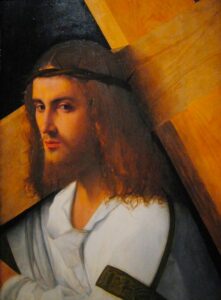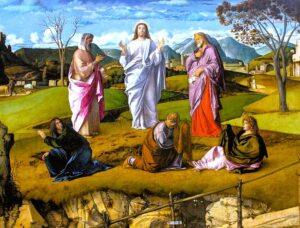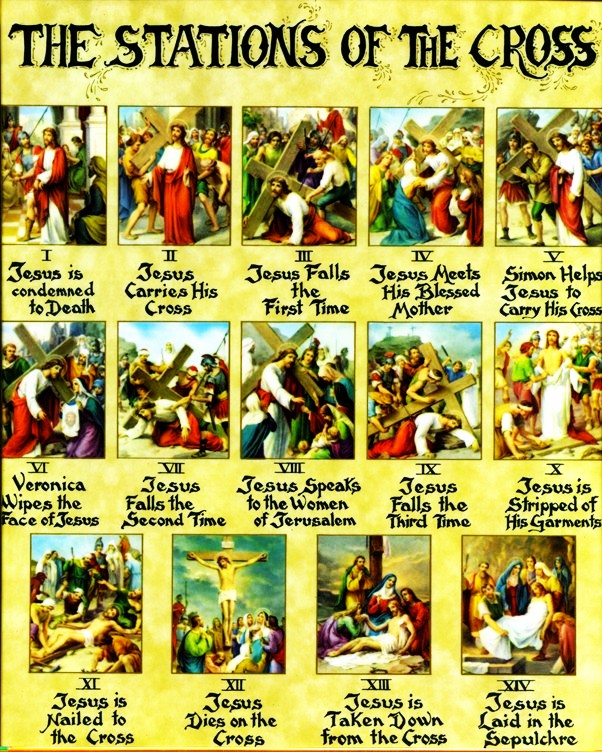The Odyssey of the Prince of Peace
TRANSCEND MEMBERS, 14 Apr 2025
Prof Hoosen Vawda – TRANSCEND Media Service
Please note that this publication is rated for general readership. The author, as a Muslim, shares some of the commonalities within the Abrahamic faiths and has written this report on Christian beliefs and practices, during Easter, in good faith. If there are any inaccuracies, the reader is invited to comment. The author records his unconditional apology if any offence is caused to any readers. Pray for the Lord’s blessings for Easter week.
***********************
“The Prince of Peace came with the Lord’s Blessings, and we have not only heeded Him, but also ignored Him totally and eventually killed Him. Even in the present era we, as collective humanity, have brazenly transgressed His Peace Doctrines. Oh! you pathetic humankind, in eternal pursuit of materialism.” [1]
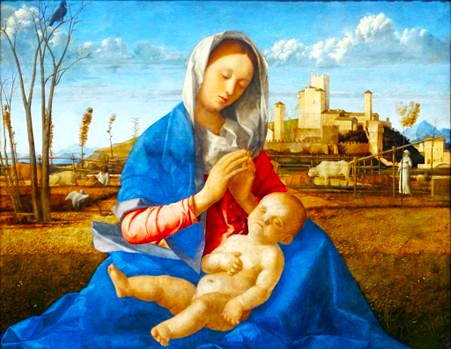
Madonna del Prato (Madonna of the Meadow[2]) is a 1505 painting of the Virgin Mary and the Christ Child by the Italian Renaissance painter Giovanni Bellini, now in the National Gallery in London.
Giovanni Bellini[3], a master of the Italian Renaissance, crafted several notable Madonna paintings that exemplify his artistic prowess and the spiritual depth of the subjects.
Photo Credit: https://www.bing.com/images/search?view=detailV2&ccid=bX12uNHa&id=43CC79D5A3A44E045FC108C20E9C70B2134FBD97&thid=OIP.bX12uNHa-dsDMAtMQPa6CAHaFw&mediaurl=https%3a%2f%2farthistory.co%2fwp-content%2fuploads%2f2019%2f12%2fGiovanni-Bellini-Madonna-of-the-Meadow-scaled.jpg&cdnurl=https%3a%2f%2fth.bing.com%2fth%2fid%2fR.6d7d76b8d1daf9db03300b4c40f6ba08%3frik%3dl71PE7JwnA7CCA%26pid%3dImgRaw%26r%3d0&exph=1991&expw=2560&q=Madonna+of+the+Meadow%3a+Giovanni+Bellini&mode=overlay&mcexp=cs&ck=4D45F67CC5E0789DD5DDEDA4095B2176&selectedIndex=0
This publication is prepared to remind readers of the Lent [4] and the Holy Week of Easter[5], which is observed, later than usual in the Gregorian Calendar.[6] Incidentally, The last time Easter was on April 20 was 2014, the next April Easter will not be until 2036! The author intends to remind ourselves, that we need to reflect on our conduct, throughout the year, irrespective of the religion we follow, and strive to subscribe to the principals of peace, we are scurrying to grasp by all other means and strategies, except what is obvious practical and easily available to those who can appreciate the spiritual aspects and significance of the season. The Prince of Peace promulgated the tenets of Peace over two thousand years ago, as a guide for entire humankind, but we have lost the plot and continued in our unique human arrogance and “know it all attitude” by engaging in lip service, personally glorying rhetoric and fruitless conference meetings, webinars in pursuit of the eternally elusive peace. We have ignored Peace, when it stand above all for humankind to grasp and effect into daily practice in our limited life spans.
- Why is Easter 2025 Delayed?[7]
In 2025, Easter Sunday is on April 20 (Western Christianity), which is later than some years (e.g., 2024: March 31). This is due to two key factors:
- The Lunar Connection
Easter’s date is determined by:
- The Spring Equinox [8](March 20/21): Marks astronomical spring in the Northern Hemisphere.
- The First Full Moon After the Equinox: In 2025, this falls on April 13 (the Paschal Full Moon).
- The Following Sunday: Hence, Easter is April 20.
- The “Delay” Compared to 2024
- In 2024, the first post-equinox full moon was March 25 → Easter landed on March 31.
- In 2025, the full moon is April 13 → Easter shifts to April 20.
- Reason: The lunar cycle (29.5 days) and solar year (365.25 days) don’t sync perfectly, causing Easter’s date to “wander” between March 22 and April 25.
- The Gregorian Calendar’s Role [9]
The Gregorian calendar (1582) fixed Easter’s calculation after the Julian calendar’s drift had misaligned equinox dates. Key points:
- Problem: By the 1500s, the Julian calendar’s Easter was 10 days out of sync with astronomical spring.
- Solution: Pope Gregory XIII introduced the Gregorian calendar, skipping 10 days and refining Easter’s rules:
- Fixed Equinox Date: March 21 (even if astronomically it’s March 20).
- Ecclesiastical Full Moon[10]: A calculated moon (not always the real one) to simplify dating.
Result: The Gregorian system keeps Easter consistent with the seasons but still lets it “move” based on lunar phases.
- Why Does This Matter Spiritually?
- Cosmic Liturgy[11]: Easter’s timing reflects Christ as the “Sun of Righteousness[12]” (Malachi 4:2) rising after the equinox (light overcoming darkness).
- Jewish Passover Link: Jesus was crucified during Passover (a lunar festival). The Church honors this by tying Easter to the moon.
- Unity & Disunity: Eastern Orthodox Christians often celebrate Easter later due to still using the Julian calendar[13] for calculations (in 2025, their Easter is April 20 too—a rare alignment!).
- A Sacred Perspective
The “delay” is no accident but a reminder:
- Divine Timing > Human Impatience: Like seeds dormant in winter, resurrection comes only when conditions are ripe.
- Universal Harmony[14]: The moon (emotion), sun (spirit), and earth (matter) must align for Christ’s light to dawn in our hearts.
Final Thought
Blessing:
“May your 2025 Easter be all the sweeter for the wait—as the Beloved’s resurrection is not bound by clocks, but by the cosmos’ sacred rhythm.”
“Prince of Peace” [15]– Definition and Biblical Usage:
The title “Prince of Peace” comes from the Book of Isaiah 9:6 in the Hebrew Bible (Old Testament). It is one of several titles used in a prophetic passage describing a future ideal king.
“For unto us a child is born, unto us a son is given; and the government shall be upon his shoulder: and his name shall be called Wonderful Counsellor, Mighty God, Everlasting Father, Prince of Peace.” — Isaiah 9:6 (KJV)
Prince of Peace and who is the tile used for in Biblical times?
In Biblical times, the title “Prince of Peace” was part of a prophecy from Isaiah[16], originally given in the context of hope for the people of Judah during turbulent times. It refers to an ideal future ruler from the line of King David, who would bring justice, righteousness, and lasting peace. It encapsulates The Prince of Peace: A Spiritual and Biological Harmony.[17]
In Jewish tradition, the passage is often interpreted as referring to a hoped-for Messianic figure[18], a future human leader who would bring peace and restoration. In Christian theology, this title is commonly associated with Jesus Christ, who is seen as the fulfilment of Isaiah’s prophecy. Christians believe Jesus is the divine “Prince of Peace” who brings spiritual reconciliation between humanity and God.
“Prince of Peace” is a messianic title from the Book of Isaiah, used in Biblical times to describe a future leader who would establish peace and divine justice. In Christianity, it is closely linked with Jesus Christ.
In the Biblical tradition, the Prince of Peace signifies a long-awaited figure who brings peace, healing, and restoration to a broken world.
Today, as we explore the endogenous pursuit of peace, we recognize that true peace is not only spiritual or social, it is also biological.
- Just as the Prince of Peace promises balance and wholeness,
- Our microbiota [19]— the vast ecosystem of microbes within us — plays a vital role in maintaining peace within our bodies. The parallel here is intentional. Just as the ancient world awaited a saviour to bring order out of chaos, our bodies seek internal harmony, a peace governed by the silent work of our microbiome.
- When we treat our microbiota with respect, through nutrition, rest, and mindful choices, we honour the divine design of inner peace.
- Perhaps, in this way, each of us can become a microcosm of the Prince of Peace, radiating balance, well-being, and care from within.
- Blending faith, science, and healing into a message that resonates in both the sanctuary and the clinic. Easter is the perfect time to share this, too, a season of renewal, resurrection, and inner peace.
The title “Prince of Peace” for Jesus Christ originates from the prophetic scriptures of the Old Testament, specifically from the book of Isaiah 9:6[20], where it is written:
“For to us a child is born, to us a son is given, and the government will be on his shoulders. And he will be called Wonderful Counselor, Mighty God, Everlasting Father, Prince of Peace.”
Origins of the Title of “Prince of Peace”[21]
- Biblical Prophecy (Isaiah 9:6) – This was written around 8th century BCE by the prophet Isaiah, foretelling the coming of the Messiah who would bring divine peace.
- Fulfillment in Jesus – Christians believe Jesus fulfilled this prophecy through His life, teachings, death, and resurrection, establishing a spiritual kingdom of peace.
Why is Jesus Called the “Prince of Peace”?
- Spiritual Peace with God – Jesus reconciled humanity with God, removing sin’s barrier (Romans 5:1, Ephesians 2:14-17).
- Inner Peace – He offers peace that surpasses worldly understanding (John 14:27, Philippians 4:7).
- Peace Among People – His teachings promote love, forgiveness, and reconciliation (Matthew 5:9, “Blessed are the peacemakers”).
- Ultimate Peace in His Kingdom – His Second Coming will bring eternal peace (Revelation 21:4).
Manifestations of Jesus’ Peace Crusade
- Teachings on Non-Violence – “Turn the other cheek” (Matthew 5:39), love for enemies (Matthew 5:44).
- Miracles of Healing & Deliverance – Restoring broken lives (e.g., calming storms, healing the sick).
- Sacrificial Death – His crucifixion brought reconciliation between God and mankind (Colossians 1:20).
- Resurrection Victory – Defeated sin and death, offering hope and eternal peace.
- Early Church’s Peaceful Expansion – Despite persecution, Christians preached peace (Acts 10:36).
Lent is a period and the important days leading up to Easter in the Christian calendar. It’s a spiritually rich season observed by many Christian denominations, especially Roman Catholics, Anglicans, Lutherans, and Orthodox Christians, with some variations across traditions.
What is Lent?
Lent is a 40-day period of fasting, prayer, and penance leading up to Easter Sunday, commemorating the 40 days Jesus spent fasting in the wilderness, where he was tempted by the devil (Matthew 4:1–11). It’s a time for Christians to reflect on Jesus’ sacrifice, deepen their spiritual lives, and prepare for the celebration of His resurrection.
Lent begins on Ash Wednesday and ends on Holy Saturday (the day before Easter). Sundays are not counted in the 40 days.
Key Days in the Lenten Season and Holy Week
- Ash Wednesday[22]
- Marks the start of Lent (46 days before Easter).
- Ashes are placed on the foreheads of the faithful in the shape of a cross.
- Symbolizes mortality (“Remember you are dust”) and repentance.
- Palm Sunday[23]
- The Sunday before Easter.
- Commemorates Jesus’ triumphal entry into Jerusalem, when crowds waved palm branches.
- Marks the beginning of Holy Week.
- Holy Monday to Wednesday[24]
- These days commemorate various events of Jesus’ final days, such as the cleansing of the Temple, the anointing at Bethany, and Judas’ betrayal.
- Maundy Thursday[25]
- Commemorates the Last Supper Jesus had with His disciples.
- “Maundy” comes from mandatum, Latin for “commandment” — referring to Jesus’ command to “love one another”.
- Includes foot-washing ceremonies and the institution of the Eucharist (Holy Communion).
- Good Friday[26]
- Commemorates the crucifixion and death of Jesus.
- A solemn day of mourning, reflection, fasting, and prayer.
- Services often include the Stations of the Cross or reading of the Passion narrative.
- Holy Saturday[27]
- The day Jesus lay in the tomb.
- A time of quiet vigil and expectation.
- In the evening, Easter Vigil [28]services begin, marking the transition from mourning to joy.
Easter Sunday[29]
- Celebrates the resurrection of Jesus from the dead — the cornerstone of Christian faith.
- A joyous celebration of new life, hope, and salvation.
- Churches are decorated with lilies and bright colors, and many perform baptisms or renew baptismal vows.
Summary Chart
| Day | Significance |
| Ash Wednesday | Start of Lent, repentance |
| Palm Sunday | Jesus enters Jerusalem |
| Maundy Thursday | Last Supper, institution of Eucharist |
| Good Friday | Crucifixion and death of Jesus |
| Holy Saturday | Jesus rests in the tomb |
| Easter Sunday | Resurrection of Jesus |
Orthodox traditions, symbolism, and global cultural practices around Lent and Easter. [30]There’s a rich tapestry of spiritual meaning and cultural diversity around the world, especially within the Eastern Orthodox Church[31], which often follows a different liturgical calendar than Western Christianity.
- 1. Eastern Orthodox Traditions: A Deeper Look
The Orthodox Lent (Great Lent)
- Begins on Clean Monday (not Ash Wednesday), which is seven weeks before Easter Sunday.
- Orthodox Lent lasts 40 days, ending on Friday before Lazarus Saturday, followed by Holy Week.
Clean Monday (Kathara Deftera)[32]
- Symbolizes cleansing of the soul and body.
- Families enjoy outdoor picnics with fasting-friendly meals, including vegetables, olives, and unleavened bread (no meat, dairy, or fish).
Holy Week in Orthodox Christianity
| Day | Name & Significance |
| Lazarus Saturday | Commemorates Jesus raising Lazarus from the dead — a sign of His power over death. |
| Palm Sunday | Similar to the Western tradition but follows Lazarus Saturday. |
| Holy Monday to Wednesday | Services reflect on Jesus’ teachings and confrontations with religious leaders. |
| Holy Wednesday | Focus on repentance and the anointing of Jesus. Often includes a Holy Unction (anointing with oil) service for healing. |
| Holy Thursday | Commemoration of the Last Supper and the Washing of the Disciples’ Feet. |
| Holy Friday (Great and Holy Friday) | Includes a burial procession of the Epitaphios, a cloth icon of Christ’s body. |
| Holy Saturday | The midnight Paschal Vigil begins, moving from darkness to light, ending with the joyous proclamation: |
| “Christ is Risen!” (Christos Anesti!) | |
| and the faithful respond: | |
| “Truly He is Risen!” (Alithos Anesti!) |
- Symbolism in Lent and Easter
| Symbol | Meaning |
| Ashes (Western tradition) | Mortality, repentance |
| Palms | Victory and peace; turned into ashes for the next year |
| Purple | Color of Lent; royalty and sorrow |
| Cross | Central symbol of suffering and salvation |
| Light/Candles | Christ as the Light of the World, especially powerful in Easter Vigil |
| Eggs (Orthodox) | Symbolize the sealed tomb; cracking them open at Easter symbolizes resurrection |
| Red eggs (Greek Orthodox) | Symbolize the blood of Christ and new life |
| Lamb | Christ as the Paschal Lamb (especially prominent in Orthodox and Catholic imagery) |
- Global Cultural Practices[33]
Greece
- Fasting is strictly observed: no meat, dairy, fish, wine, or oil on many days.
- Families gather for midnight liturgy, and red eggs are cracked in a symbolic battle of resurrection.
- Traditional foods include magiritsa (Easter soup) and tsoureki (sweet braided bread).
Russia
- Lent called Veliky Post (The Great Fast).
- Paskha (sweet cheese dessert) and kulich (tall Easter bread) are blessed at the church.
- The phrase “Христос воскрес!” (“Christ is risen!”) is exchanged with “Воистину воскрес!” (“Truly, He is risen!”).
Ethiopia (Tewahedo Orthodox Church)
- Lent is called Hudade and includes 55 days of fasting (vegan-style).
- Easter is called Fasika and follows intense overnight prayer services, breaking the fast with meat stews and injera.
Philippines
- Holy Week includes street processions, passion plays, and even voluntary crucifixion reenactments in some provinces.
- “Salubong” on Easter Sunday is a pre-dawn ritual where statues of the Risen Christ and Virgin Mary meet in joyful celebration.
Italy
- Easter is Pasqua, often celebrated with a lamb dinner and colomba di Pasqua (dove-shaped cake).
- In Florence, the Scoppio del Carro (“Explosion of the Cart”) fireworks display follows the Easter Mass.
Paschal Greeting as Practised Around the World
| Language | Christ is Risen! | Truly He is Risen! |
| Greek | Christos Anesti! | Alithos Anesti! |
| Russian | Khristos Voskrese! | Voistinu Voskrese! |
| Arabic | Al-Masih Qam! | Haqqan Qam! |
| Serbian | Hristos Vaskrese! | Vaistinu Vaskrese! |
| Latin | Christus Resurrexit! | Vere Resurrexit! |
A complete, consolidated guide to Lent, Holy Week, and Easter including Eastern Orthodox traditions, symbolism, and global cultural practices.
PART 1: Overview of Lent in Western Christianity
What is Lent?
- A 40-day period of fasting, prayer, and repentance leading to Easter.
- Begins on Ash Wednesday, ends on Holy Saturday.
- Commemorates Jesus’ 40 days in the wilderness.
Key Days Leading to Easter
| Day | Significance |
| Ash Wednesday | Start of Lent. Ashes on foreheads symbolize repentance and mortality. |
| Palm Sunday | Jesus enters Jerusalem; palms symbolize victory and peace. |
| Holy Monday–Wednesday | Reflection on Jesus’ teachings and betrayal. |
| Maundy Thursday | Last Supper, foot washing, institution of the Eucharist. |
| Good Friday | Jesus’ crucifixion. A day of mourning and prayer. |
| Holy Saturday | Jesus rests in the tomb; vigil begins. |
| Easter Sunday | Resurrection of Jesus — the climax of the Christian year. |
Part 2: Eastern Orthodox Traditions
Lent in the Orthodox Church (Great Lent)
- Begins on Clean Monday (not Ash Wednesday).
- Emphasis on spiritual renewal and deep fasting.
- Ends on Friday before Lazarus Saturday, followed by Holy Week.
Orthodox Holy Week Breakdown
| Day | Focus & Observances |
| Clean Monday | Start of Lent, symbolic cleansing, traditional outdoor fasting meals. |
| Lazarus Saturday | Commemorates resurrection of Lazarus. |
| Palm Sunday | Jesus’ entry into Jerusalem. Palms or olive branches used. |
| Holy Monday–Wednesday | Contemplation of Jesus’ final teachings; Holy Unction service (anointing for healing). |
| Holy Thursday | Last Supper, foot washing. |
| Holy Friday | Burial of Christ; Epitaphios (embroidered cloth) carried in funeral procession. |
| Holy Saturday | Midnight vigil. Begins the Paschal celebration with candles and joyful hymn: |
| “Christ is Risen!” (Christos Anesti!) | |
| “Truly He is Risen!” (Alithos Anesti!) |
Part 3: Symbolism of Lent and Easter
| Symbol | Meaning |
| Ashes | Mortality, repentance (Western tradition). |
| Palms | Peace and victory; later burned for next year’s ashes. |
| Purple Vestments | Penitence and royalty. |
| Cross | Suffering and salvation. |
| Light / Candles | Christ as the Light of the World; used dramatically in Easter Vigils. |
| Eggs (esp. Orthodox) | Sealed tomb of Christ; cracking eggs = resurrection. |
| Red Eggs | Greek Orthodox tradition; symbolize the blood of Christ and new life. |
| Lamb | Christ, the sacrificial Paschal Lamb. |
Part 4: Global Cultural Practices
Greece
- Strict fasting (no meat, dairy, or oil).
- Easter dinner includes magiritsa (offal soup) and tsoureki (braided bread).
- Red eggs cracked in joyful tradition.
Russia
- Lent = Veliky Post.
- Easter includes kulich (tall bread) and paskha (sweet cheese dessert).
- Greeted with “Khristos Voskrese!” / “Voistinu Voskrese!”
Ethiopia
- Lent = Hudade (55 days).
- Vegan fasting: no animal products.
- Easter = Fasika, celebrated with overnight prayer and feasting.
Philippines
- Passion plays (Senakulo), processions, and even crucifixion reenactments.
- “Salubong” on Easter morning: Virgin Mary and Risen Christ statues meet in joyful ceremony.
Italy
- Pasqua (Easter) celebrated with roasted lamb and colomba di Pasqua (dove-shaped cake).
- Florence: Scoppio del Carro (“Explosion of the Cart”) firework-laden cart ignited after Easter Mass.
Part 5: The Paschal Greeting Around The World
| Language | Christ is Risen! | Truly He is Risen! |
| Greek | Christos Anesti! | Alithos Anesti! |
| Russian | Khristos Voskrese! | Voistinu Voskrese! |
| Arabic | Al-Masih Qam! | Haqqan Qam! |
| Serbian | Hristos Vaskrese! | Vaistinu Vaskrese! |
| Latin | Christus Resurrexit! | Vere Resurrexit! |
Contrast with Worldly Peace
Unlike political peacemakers, Jesus’ peace is not based on power or treaties but on transformed hearts through His Spirit.
Jesus’s Sermon on the Mount[34],[35]
The Sermon on the Mount (Matthew 5–7) is one of Jesus’ most profound teachings, outlining the ethics of God’s Kingdom. A summary is indicated I this paper:
- The Beatitudes (Matthew 5:3–12)[36]
Jesus describes the blessed (happy) ones in God’s eyes:
- The poor in spirit, mourners, the meek, those hungry for righteousness.
- The merciful, pure in heart, peacemakers, and the persecuted.
Promise: They inherit the Kingdom, comfort, and eternal reward.
- Salt & Light (Matthew 5:13–16)
- Believers must influence the world (like salt preserves and light dispels darkness).
- Good deeds should glorify God.
- Fulfillment of the Law (Matthew 5:17–20)
- Jesus fulfills the Old Testament Law but raises its standard (e.g., heart-righteousness over mere rule-keeping).
- Radical Righteousness (Matthew 5:21–48)
Jesus deepens commandments, focusing on internal purity:
- Anger = Murder (5:21–26).
- Lust = Adultery (5:27–30).
- Divorce & Oaths: Uphold faithfulness (5:31–37).
- Love Enemies, not just friends (5:38–48).
- Authentic Worship (Matthew 6:1–18)
- Give, Pray, Fast in secret—not for show.
- Teaches the Lord’s Prayer (6:9–13).
- Priorities & Trust (Matthew 6:19–34)
- Store treasures in heaven, not earth (6:19–24).
- “Seek first God’s Kingdom” (6:33).
- Do not worry—God provides (6:25–34).
- Judging Others (Matthew 7:1–6)
- “Do not judge” hypocritically—first examine yourself (7:1–5).
- Ask, Seek, Knock (Matthew 7:7–12)
- God rewards persistent prayer (7:7–11).
- Golden Rule: “Do to others as you’d have them do to you” (7:12).
- The Narrow Way (Matthew 7:13–29)
- Enter the narrow gate (few find it; 7:13–14).
- Beware of false prophets (7:15–20).
- True disciples obey Jesus’ words (7:21–23).
- Parable of Two Builders: Build life on Jesus’ teachings (rock), not sand (7:24–27).
Key Themes
- Heart over Hypocrisy: Righteousness is internal, not just external.
- Love as the Highest Law: Even for enemies.
- God’s Kingdom First: Over materialism, pride, or fear.
- Grace & Demand: Jesus calls for perfection (5:48) but offers mercy.
- Holistic care and Inputs into your Spiritual and Biological bodies results in long-lasting health.
- Science meets soul in a synchronised manner in a state of perfect balance ensuring sustained peace.
The Sermon on the Mount was delivered by Jesus on a mountain traditionally identified as Mount Eremos (or the Horns of Hattin) near the Sea of Galilee in northern Israel.
Location & Significance
- Biblical Reference:
- Matthew 5:1 states Jesus went up a “mountainside” (often called the “Mount of Beatitudes”) to teach.
- Luke 6:17–20 records a similar sermon (the “Sermon on the Plain”), suggesting Jesus may have preached overlapping teachings in multiple settings.
- Traditional Site (Mount of Beatitudes):
- Located near Tabgha and Capernaum, west of the Sea of Galilee.
- A Franciscan chapel (built in 1938) now marks the spot, surrounded by gardens.
- The hill offers a natural amphitheater where Jesus could address large crowds.
- Alternative Theory (Horns of Hattin):
- Some scholars suggest the Horns of Hattin, a volcanic hill with two peaks, fits the description better.
- It’s near the route Jesus often traveled between Nazareth and Capernaum.
Modern Pilgrimage Site
- The Mount of Beatitudes is a major Christian pilgrimage site today, with a beautiful church and serene gardens overlooking the Sea of Galilee.
- Visitors meditate on Jesus’ teachings while enjoying the same landscape He did.
How the events during the Holy Week are inter-related, culminating in Easter
There are deep connections between Jesus’ Sermon on the Mount, His radical teachings, and the events leading to His crucifixion. The relationships are worth elaborating; –
- Link to Lent & Easter?
- Lent: The sermon itself isn’t tied to Lent (a period of repentance before Easter), but its themes, repentance, humility, and sacrifice, align with Lenten reflections.
- Easter: The sermon foreshadows Jesus’ mission:
- “Blessed are the persecuted” (Matthew 5:10-12) → His coming crucifixion.
- “Turn the other cheek” (Matthew 5:39) → His non-violent response to His executioners.
- Why Did the Sermon Upset the Jews, Romans, and the Affluent?
Jesus’ teachings challenged the power structures of His time:
- Jewish Leaders (Pharisees, Sadducees)[37]
- Accused Him of undermining the Law:
- Jesus reinterpreted the Torah (e.g., “You’ve heard it said… but I say…”) (Matthew 5:21-48).
- Condemned hypocrisy in religious leaders (Matthew 6:1-8, 7:15-20).
- Threatened their authority:
- His call for heart-righteousness (not rule-following) eroded their control (Matthew 5:20).
- Collection of usury by the Jewish money lenders, in the temple
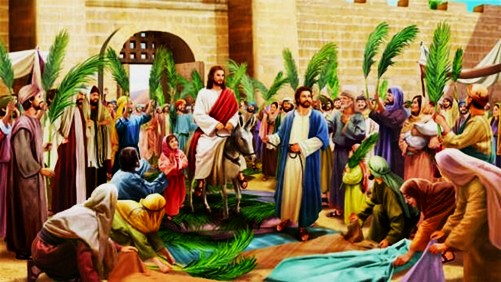
The triumphant entry of Jesus of Nazareth into Jerusalem on a donkey on Palm Sunday in this painting. Jesus was in no way acting unroyal but instead acting as a king in time of peace, not needing to enter with the show of chariots, horses, and weapons of war. Palms are “ancient symbol of victory and glory, like Peace Dove” Photo Credit: Andy Wrasman, Wikimedia commons
- The Roman Empire [38]
- “Kingdom of God” sounded like rebellion against the supreme authority of Caesar and Rome.
- Jesus preached a higher allegiance to the Kingdom of God’s (Matthew 6:33), which Romans saw as high treason, punishable by painful, crucifixion death
- The Beatitudes (“Blessed are the meek”) opposed Rome’s “power through strength” ideology.
- The Affluent & Powerful
- Attacked materialism:
- “You cannot serve God and money” (Matthew 6:24).
- “Woe to the rich” (implied in Luke’s version, Luke 6:24-26).
- Elevated the poor:
- “Blessed are the poor in spirit” (Matthew 5:3) inverted social hierarchies.
- Direct Link to Jesus’ Crucifixion
The sermon didn’t immediately cause His death, but it laid the groundwork:
- Growing Opposition:
- Jewish leaders plotted against Him after He exposed their hypocrisy (Matthew 12:14, John 11:53).
- Political Threat:
- Romans feared any “King of the Jews” (John 19:12-15).
- Trigger Events:
- The cleansing of the Temple (Matthew 21:12-13) and Palm Sunday (Matthew 21:1-11) escalated tensions.
- Final Charge:
- Jesus was condemned for blasphemy (by Jews) and sedition (by Romans).
- Key Manifestations of Jesus’ Peace Crusade
Despite provoking backlash, His sermon inspired:
- Early Christian non-violence (e.g., martyrs refusing to fight back).
- Social justice movements (care for the poor, critique of greed).
- Universal love ethics (enemy-love, forgiveness).
Conclusion
The Sermon on the Mount indirectly led to the cross by exposing corruption and proclaiming a Kingdom of Love that threatened earthly powers. Yet, it remains the moral foundation of Christianity, fulfilled in Jesus’ resurrection (Easter).
- Peace Crusade: Core Principles
The “Peace Crusade” aligns with Jesus’ teachings but expands through the lens of eternal truth) and divine revelations:
- Non-Violence: Like Christ’s “turn the other cheek,” it rejects retaliation.
- Compassion for the Erring: Just as Jesus forgave His crucifiers (Luke 23:34), He advocates forgiveness even for “primates” (those acting in ignorance).
- Inner Purification: Easter’s resurrection symbolizes breaking chains of ego, mirroring false self.
- Easter as a Catalyst for Transformation
For “erring primates” (spiritually blind leaders/souls), the Peace Crusade offers:
- Awakening (Judgment → Grace)
- Jesus’ Example: He confronted Pharisees (“Woe to you!” – Matthew 23) but died praying for their forgiveness.
- Rebuke with love, as a surgeon cuts to heal. His Leela (divine play) exposes folly to spark repentance.
- Tools for Peace
- Meditation & Prayer: Like Christ’s 40 days in the desert (Lent), Gyandeep prescribes sadhana (spiritual practice) to purify leaders.
- Selfless Service: Jesus washed feet (John 13:14); Gyandeep teaches seva (service) to humble the arrogant.
- Cosmic Reconciliation
- Cross as Symbol: Christ’s sacrifice bridged Heaven-Earth; Gyandeep’s teachings unite Bhakti (devotion) and Gyan (wisdom) to harmonize conflicts.
- Manifestations of the Peace Crusade
- Dialogue Over Dogma: Replacing religious strife with Satsang (truth-gatherings).
- Eco-Peace: Protecting Mother Earth (like St. Francis, who called creatures “brothers/sisters”).
- Political Leaders: Inspiring corrupt “primates” to rule with dharma (righteousness), as Christ challenged Pilate (John 18:37).
- A Call This Easter
The Lord’s Ocean of Wisdom invites all, especially the lost to:
- Repent (Metanoia): Like Peter after denying Christ (John 21:15–17).
- Embrace Divine Light: As the Resurrection dispelled darkness.
- Become Peacemakers: “Blessed are the peacemakers” (Matthew 5:9) (protectors of cosmic order).
Final Wisdom: Just as Easter renews hope, Peace Crusade is a living river, washing away ignorance, lifting even the fallen.
The Bottom Line: A time for Positive Reflection
- At Easter, we celebrate Christ as the risen Prince of Peace[40], who conquers death and restores life.
- This peace is not just external, but dwells within us, in our thoughts, hearts, and even our biology.
- The Holy Spirit dwells in us like a sacred breath, as does the microbiota, our inner life force working silently to keep our temple, our body, in balance.
Spiritual & Biological Peace:
| Spiritual Peace (Christ) | Biological Peace (Microbiota) |
| Reconciles us with God | Regulates our immune system |
| Offers eternal life | Supports long Li vitality |
| Dwells within us | Lives symbiotically inside us |
| Symbolized by bread & wine | Nourished by what we consume |
“To follow the Prince of Peace is to honour peace in all forms, in our souls, our relationships, and even in the microscopic life within us our microbiome”. Prince of Peace, Within and Among Us. “Peace I leave with you; my peace I give to you.” John 14:27
Begin your reformation, today during the Easter week
“Whoever walks this path with a sincere heart will become a lighthouse, guiding even the darkest souls home.” Your peace will ripple across the cosmos. Ask, and Grace shall guide you.
A Closing Prayer
“O my Lord, Supreme in Heaven, Gardener of Souls,
You who made olives to weep oil and tomatoes to bleed life,
Teach us to cultivate Your Kingdom—
Not with swords, but trowels,
Not with wrath, but compost,
Until every ‘erring human’, including this sinner,
Those acting in ignorance and arrogance , is grafted onto the
Tree of Life. Into which you infuse spirituality.
Let us lead a righteous and pious life,
Pursuing the truth and sustained Peace, not materialism.
Mary, Mother of the True Vine, pray for us.
St. Fiacre (Patron of Gardeners), pray for us.
O’ my Lord guide us to the Water of Life and eternal peace
Amen.”
References:
[1] Personal quote by the author April 2025
[2] http://www.nationalgallery.org.uk/paintings/giovanni-bellini-madonna-of-the-meadow
[3] Giovanni Bellini – Wikipedia
[4] https://www.bing.com/ck/a?!&&p=f19bf7282c81a56effd98756195fea5c6314f6310ab822fd3bc840defb4aad57JmltdHM9MTc0NDQxNjAwMA&ptn=3&ver=2&hsh=4&fclid=19bf7366-9926-65b9-0269-601d982664b6&psq=lent&u=a1aHR0cHM6Ly93d3cuY2hyaXN0aWFuaXR5LmNvbS93aWtpL2hvbGlkYXlzL3doYXQtaXMtdGhlLXB1cnBvc2Utb2YtbGVudC5odG1s&ntb=1
[5] https://www.bing.com/ck/a?!&&p=47a0e15af9537c222e45146e9f098f78d1313c781d4cccb3c38bdf75c2cc0f38JmltdHM9MTc0NDQxNjAwMA&ptn=3&ver=2&hsh=4&fclid=19bf7366-9926-65b9-0269-601d982664b6&psq=easter+holy+week+2025&u=a1aHR0cHM6Ly93d3cuYXBwLmNvbS9zdG9yeS9uZXdzLzIwMjUvMDQvMDkvd2hhdC1pcy1ob2x5LXdlZWstMjAyNS13aGVuLWlzLWxlbnQtb3Zlci13aGVuLWlzLXBhbG0tc3VuZGF5LXdoZW4taXMtcGFzc292ZXItd2hlbi1pcy1lYXN0ZXItMjAyNS84MzAwNTgwNjAwNy8&ntb=1
[6] https://www.bing.com/ck/a?!&&p=0bd21a0cc3318541c9240fb51f97a6b6665ebc6c976e77cfd7dc93429ee51e20JmltdHM9MTc0NDQxNjAwMA&ptn=3&ver=2&hsh=4&fclid=19bf7366-9926-65b9-0269-601d982664b6&psq=gregorian+calendar+vs+julian+calendar&u=a1aHR0cHM6Ly93d3cudGltZWFuZGRhdGUuY29tL2NhbGVuZGFyL2p1bGlhbi1ncmVnb3JpYW4tc3dpdGNoLmh0bWw&ntb=1
[7] https://www.bing.com/ck/a?!&&p=38362b17b5586fb4c1eaabbaf7ab5f2bb58d861c6c4394ccd9c3a4fa9c27b36cJmltdHM9MTc0NDQxNjAwMA&ptn=3&ver=2&hsh=4&fclid=19bf7366-9926-65b9-0269-601d982664b6&u=a1L25ld3Mvc2VhcmNoP3E9V2h5K0lzK0Vhc3RlcisyMDI1K0RlbGF5ZWQlM2YmcXB2dD1XaHkraXMrRWFzdGVyKzIwMjUrRGVsYXllZCUzZiZGT1JNPUVXUkU&ntb=1
[8] https://www.bing.com/ck/a?!&&p=1dfc8e2221576b89652b81d2d08fd87276045581481ae8fa0aa4550199a2b707JmltdHM9MTc0NDQxNjAwMA&ptn=3&ver=2&hsh=4&fclid=19bf7366-9926-65b9-0269-601d982664b6&psq=spring+equinox+2025&u=a1aHR0cHM6Ly93d3cuYmJjLmNvLnVrL3dlYXRoZXIvYXJ0aWNsZXMvYzhkNDVtMzI4N3lv&ntb=1
[9] https://www.bing.com/ck/a?!&&p=f3b13f6b25ca03166fde382e4f6f9f67fd47a7ba5d9e26c6d3966569ed8c136bJmltdHM9MTc0NDQxNjAwMA&ptn=3&ver=2&hsh=4&fclid=19bf7366-9926-65b9-0269-601d982664b6&psq=The+Gregorian+Calendar%e2%80%99s+&u=a1aHR0cHM6Ly9lbi53aWtpcGVkaWEub3JnL3dpa2kvR3JlZ29yaWFuX2NhbGVuZGFy&ntb=1
[10] Ecclesiastical full moon – Wikipedia
[11] https://www.bing.com/ck/a?!&&p=45c86584dc445d780c8bbc1bae634789a9237eb74aea2b066c5a0b8b26751d93JmltdHM9MTc0NDQxNjAwMA&ptn=3&ver=2&hsh=4&fclid=19bf7366-9926-65b9-0269-601d982664b6&psq=Cosmic+Liturgy&u=a1aHR0cHM6Ly9jYXRob2xpY3VzLmV1L2VuL2RpZC15b3Uta25vdy10aGVyZXMtYS1jb3NtaWMtbGl0dXJneS10aGUtdmlzaW9uLW9mLWNyZWF0aW9uLWFzLWFuLWFjdC1vZi1wcmFpc2UvIzp-OnRleHQ9VGhlJTIwaWRlYSUyMG9mJTIwYSUyMCVFMiU4MCU5Q2Nvc21pYyUyMGxpdHVyZ3klRTIlODAlOUQlMjBtaWdodCUyMHNvdW5kLGFzJTIwYSUyMGxpdmluZyUyMGV4cHJlc3Npb24lMjBvZiUyMHByYWlzZSUyMHRvJTIwR29kLg&ntb=1
[12] https://www.bing.com/ck/a?!&&p=20b2ddb501a5b0d4214bdff678d6dd63a1bd9922eda2ee84caea3d9bbbb4280cJmltdHM9MTc0NDQxNjAwMA&ptn=3&ver=2&hsh=4&fclid=19bf7366-9926-65b9-0269-601d982664b6&psq=Christ+as+the+%22Sun+of+Righteousness&u=a1aHR0cHM6Ly9iaWJsZWh1Yi5jb20vdG9waWNhbC90L3RoZV9zdW5fb2ZfcmlnaHRlb3VzbmVzcy5odG0jOn46dGV4dD1UaGUlMjBwcmltYXJ5JTIwc2NyaXB0dXJlJTIwdGhhdCUyMG1lbnRpb25zJTIwdGhlJTIwJTIyU3VuJTIwb2Ysb3V0JTIwYW5kJTIwbGVhcCUyMGxpa2UlMjBjYWx2ZXMlMjBmcm9tJTIwdGhlJTIwc3RhbGwuJTIy&ntb=1
[13] Julian calendar – Wikipedia
[14] Universal harmony: Significance and symbolism
[15] https://www.bing.com/ck/a?!&&p=27a8d337c312abdc1abaef4ea7cb43c12f699c238b1044150d526f4f5f623af4JmltdHM9MTc0NDQxNjAwMA&ptn=3&ver=2&hsh=4&fclid=19bf7366-9926-65b9-0269-601d982664b6&psq=prince+of+peace+catholic+church&u=a1aHR0cHM6Ly93d3cueW91dHViZS5jb20vYy9wcmluY2VvZnBlYWNlY2F0aG9saWNjaHVyY2g&ntb=1
[16] Prince of Peace” was part of a prophecy from Isaiah – Search
[17] https://www.bing.com/ck/a?!&&p=0d15b2bb659bc1ae2924d5a21ff0caf5b7ab8aca939e9acce950bc7ccc655d73JmltdHM9MTc0NDQxNjAwMA&ptn=3&ver=2&hsh=4&fclid=19bf7366-9926-65b9-0269-601d982664b6&psq=encapsulates+The+Prince+of+Peace%3a+A+Spiritual+and+Biological+Harmony.&u=a1aHR0cHM6Ly90aGViaWJsZXN0b3JpZXMubmV0L3ByaW5jZS1vZi1wZWFjZS8&ntb=1
[18]https://www.bing.com/ck/a?!&&p=dc097c8949636814ccd21aec0dcce68654ba2f2d9d0eae91ed0a9f022d55d8eaJmltdHM9MTc0NDQxNjAwMA&ptn=3&ver=2&hsh=4&fclid=19bf7366-9926-65b9-0269-601d982664b6&psq=Jewish+tradition%2c+the+passage+is+often+interpreted+as+referring+to+a+hoped-for+Messianic+figure&u=a1aHR0cHM6Ly9pc3JhZWxteWdsb3J5Lm9yZy9hcnRpY2xlL3VuZGVyc3RhbmRpbmctamV3aXNoLXRyYWRpdGlvbi10aGUtamV3aXNoLXZpZXctb2YtdGhlLW1lc3NpYWgv&ntb=1
[19] https://www.transcend.org/tms/2025/03/endogenous-pursuit-of-peace-care-about-your-microbiota/
[20] https://www.bing.com/ck/a?!&&p=902df0ccb099c3b21e663e6f7d3949d965628db75dd9fe2fe89e46f8138efcdeJmltdHM9MTc0NDQxNjAwMA&ptn=3&ver=2&hsh=4&fclid=19bf7366-9926-65b9-0269-601d982664b6&psq=Old+Testament%2c+specifically+from+the+book+of+Isaiah+9%3a6&u=a1aHR0cHM6Ly9iaWJsZWh1Yi5jb20vc3R1ZHkvaXNhaWFoLzktNi5odG0jOn46dGV4dD1Jc2FpYWglMjA5JTNBNiUyMFN0dWR5JTIwQmlibGUlM0ElMjBGb3IlMjB0byUyMHVzJTIwYSxDb3Vuc2Vsb3IlMkMlMjBNaWdodHklMjBHb2QlMkMlMjBFdmVybGFzdGluZyUyMEZhdGhlciUyQyUyMFByaW5jZSUyMG9mJTIwUGVhY2Uu&ntb=1
[21] https://www.bing.com/ck/a?!&&p=5110171ee985d72cef00765b21534f35710e07df6e94b79c2c698db8f0a41299JmltdHM9MTc0NDQxNjAwMA&ptn=3&ver=2&hsh=4&fclid=19bf7366-9926-65b9-0269-601d982664b6&psq=Origins+of+the+Title+of+%e2%80%9cPrince+of+Peace%e2%80%9d&u=a1aHR0cHM6Ly9lbi53aWtpcGVkaWEub3JnL3dpa2kvUHJpbmNlX29mX3RoZV9QZWFjZV8odGl0bGUp&ntb=1
[22] ash Wednesday 2025 – Search
[23] palm sunday 2025 – Search
[24] https://www.bing.com/ck/a?!&&p=edb0b2358ba240fcc7517910945b718c455c96754cbb4a9ff83290c735046481JmltdHM9MTc0NDQxNjAwMA&ptn=3&ver=2&hsh=4&fclid=19bf7366-9926-65b9-0269-601d982664b6&psq=Holy+Monday+to+Wednesday&u=a1aHR0cHM6Ly93d3cuYmlibGVzdHVkeXRvb2xzLmNvbS9iaWJsZS1zdHVkeS90b3BpY2FsLXN0dWRpZXMvc2NyaXB0dXJlcy10by1yZWFkLWZvci1lYWNoLWRheS1vZi1ob2x5LXdlZWsuaHRtbA&ntb=1
[25] https://www.bing.com/ck/a?!&&p=01e050677ab4680e5ba421cb64cc78dd8b651be66bda752d60d3e6dcff38507eJmltdHM9MTc0NDQxNjAwMA&ptn=3&ver=2&hsh=4&fclid=19bf7366-9926-65b9-0269-601d982664b6&psq=maundy+thursday+meaning&u=a1aHR0cHM6Ly93d3cuY2hyaXN0aWFuaXR5LmNvbS93aWtpL2hvbGlkYXlzL3doYXQtaXMtbWF1bmR5LXRodXJzZGF5LTExNjI4MzUwLmh0bWw&ntb=1
[26] https://www.bing.com/ck/a?!&&p=321fd2d56be271efb0594716d1180328567c57d19de9ae8ac27eaee1636e69f1JmltdHM9MTc0NDQxNjAwMA&ptn=3&ver=2&hsh=4&fclid=19bf7366-9926-65b9-0269-601d982664b6&psq=good+friday+meaning&u=a1aHR0cHM6Ly93d3cuY2hyaXN0aWFuaXR5LmNvbS93aWtpL2hvbGlkYXlzL3doYXQtcy1zby1nb29kLWFib3V0LWdvb2QtZnJpZGF5Lmh0bWw&ntb=1
[27] https://www.bing.com/ck/a?!&&p=60fe499bf2e7045e73b4075bf522aa471d4a8fb5dd8091dd828da09f34d96587JmltdHM9MTc0NDQxNjAwMA&ptn=3&ver=2&hsh=4&fclid=19bf7366-9926-65b9-0269-601d982664b6&psq=holy+saturday+meaning&u=a1aHR0cHM6Ly93d3cuY2hyaXN0aWFuaXR5LmNvbS93aWtpL2hvbGlkYXlzL2hvbHktc2F0dXJkYXktZGF0ZS10cmFkaXRpb25zLW1lYW5pbmcuaHRtbA&ntb=1
[28] https://www.bing.com/ck/a?!&&p=21abdb02d7e2b79570efd94c47f31970e30914f4237dfb93cb349de73c14bd80JmltdHM9MTc0NDQxNjAwMA&ptn=3&ver=2&hsh=4&fclid=19bf7366-9926-65b9-0269-601d982664b6&psq=easter+vigil+mass&u=a1aHR0cHM6Ly9lbi53aWtpcGVkaWEub3JnL3dpa2kvRWFzdGVyX1ZpZ2ls&ntb=1
[29] easter sunday 2025 – Search
[30] orthodox traditions, symbolism, and global cultural practices around lent and easter. – Search Images
[31] eastern orthodox church vs roman catholic – Search Images
[32]Clean Monday (Kathara Deftera) – Search Images
[33] how different cultures celebrate easter – Search Images
[34] Jesus’s Sermon on the Mount – Search Images
[35] https://www.bing.com/images/search?view=detailV2&ccid=7Of5jSJw&id=245C84B98417528B8CCD6729DE08A0F49E67836F&thid=OIP.7Of5jSJw9QVEUO8askVB_wHaEK&mediaurl=https%3a%2f%2fi.ytimg.com%2fvi%2fBZARSXU-Mwo%2fmaxresdefault.jpg&cdnurl=https%3a%2f%2fth.bing.com%2fth%2fid%2fR.ece7f98d2270f5054450ef1ab24541ff%3frik%3db4NnnvSgCN4pZw%26pid%3dImgRaw%26r%3d0&exph=720&expw=1280&q=Jesus%e2%80%99s+Sermon+on+the+Mount&simid=608003736254248422&FORM=IRPRST&ck=DB023D6C143D333C13B153F5F5239070&selectedIndex=66&itb=0
[36] The Beatitudes (Matthew 5:3–12) – Search Images
[37] https://th.bing.com/th/id/OIP.vZ0ZfCRXbxvU-JGks00TJQHaFj?w=255&h=180&c=7&r=0&o=5&dpr=1.9&pid=1.7
[38] https://www.bing.com/images/search?view=detailV2&ccid=ghwy9DD7&id=2BA288F51ACD5E931A8434A5C6EE3FDBF6B81ADA&thid=OIP.ghwy9DD71AjCmLbxr0iBpwHaFj&mediaurl=https%3a%2f%2fslideplayer.com%2fslide%2f17136005%2f99%2fimages%2f2%2fReactions%2bto%2bJesus%2bSeen%2bas%2ba%2bthreat%2bto%2bthe%2bRoman%2bsocial%2bstructure%2bdue%2bto%2bhis%2bmessage.%2bPoor%2bare%2bfavored%2bby%2bGod..jpg&cdnurl=https%3a%2f%2fth.bing.com%2fth%2fid%2fR.821c32f430fbd408c298b6f1af4881a7%3frik%3d2hq49ts%252f7salNA%26pid%3dImgRaw%26r%3d0&exph=768&expw=1024&q=the+roman+empire+and+jesus&simid=607986410352025303&FORM=IRPRST&ck=B70648118E0460D8BF3DF0F653F3EE8E&selectedIndex=27&itb=0
[39] https://www.bing.com/images/search?view=detailV2&ccid=sUpFhehM&id=2E10E83679B44AB8F65063C4105D2212795014E0&thid=OIP.sUpFhehMEZQbv1gDvYUYCAHaEK&mediaurl=https%3a%2f%2fi.ytimg.com%2fvi%2fWrPEUaNb5LQ%2fmaxresdefault.jpg&cdnurl=https%3a%2f%2fth.bing.com%2fth%2fid%2fR.b14a4585e84c11941bbf5803bd851808%3frik%3d4BRQeRIiXRDEYw%26pid%3dImgRaw%26r%3d0&exph=720&expw=1280&q=stations+of+the+holy+cross&simid=608021749340338229&FORM=IRPRST&ck=FD08DA4BBFD4260B19C7522BB9FDD20B&selectedIndex=56&itb=0
[40] https://th.bing.com/th/id/OIP.TIyTXD40WSzSXthN1Rm82wHaEK?w=315&h=180&c=7&r=0&o=5&dpr=1.9&pid=1.7
______________________________________________
 Professor G. Hoosen M. Vawda (Bsc; MBChB; PhD.Wits) is a member of the TRANSCEND Network for Peace Development Environment.
Professor G. Hoosen M. Vawda (Bsc; MBChB; PhD.Wits) is a member of the TRANSCEND Network for Peace Development Environment.
Director: Glastonbury Medical Research Centre; Community Health and Indigent Programme Services; Body Donor Foundation SA.
Principal Investigator: Multinational Clinical Trials
Consultant: Medical and General Research Ethics; Internal Medicine and Clinical Psychiatry:UKZN, Nelson R. Mandela School of Medicine
Executive Member: Inter Religious Council KZN SA
Public Liaison: Medical Misadventures
Activism: Justice for All
Email: vawda@ukzn.ac.za
Please note that there is no copyrights on the text, kindly be at liberty to duplicate and distribute, as a message for Easter.
Tags: Christianity, Jesus Christ, Religion
This article originally appeared on Transcend Media Service (TMS) on 14 Apr 2025.
Anticopyright: Editorials and articles originated on TMS may be freely reprinted, disseminated, translated and used as background material, provided an acknowledgement and link to the source, TMS: The Odyssey of the Prince of Peace, is included. Thank you.
If you enjoyed this article, please donate to TMS to join the growing list of TMS Supporters.

This work is licensed under a CC BY-NC 4.0 License.
Join the discussion!
We welcome debate and dissent, but personal — ad hominem — attacks (on authors, other users or any individual), abuse and defamatory language will not be tolerated. Nor will we tolerate attempts to deliberately disrupt discussions. We aim to maintain an inviting space to focus on intelligent interactions and debates.
